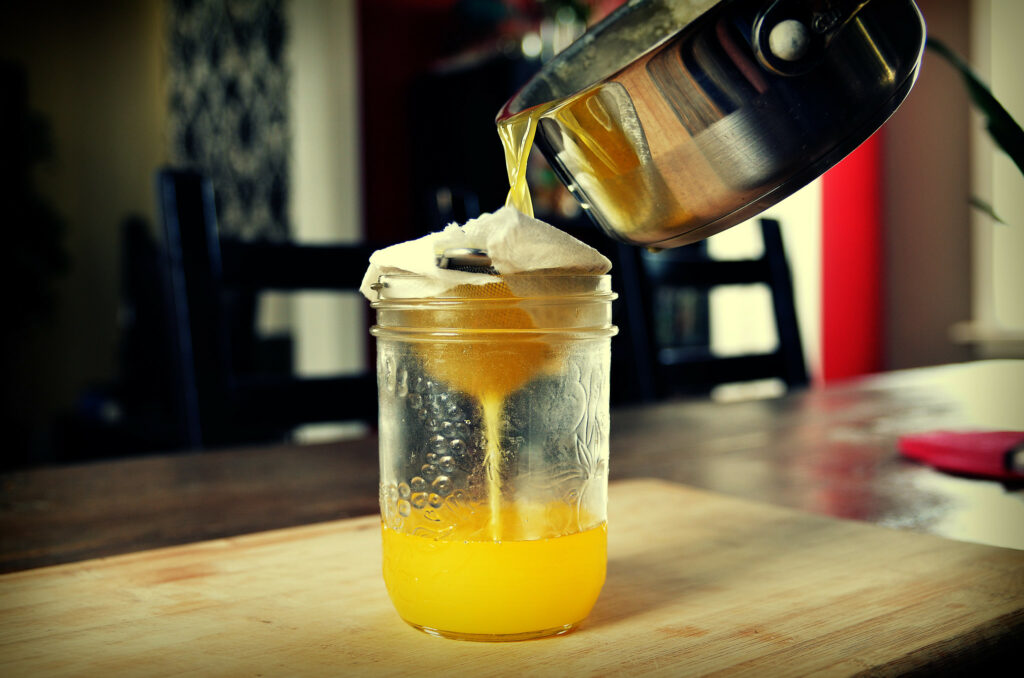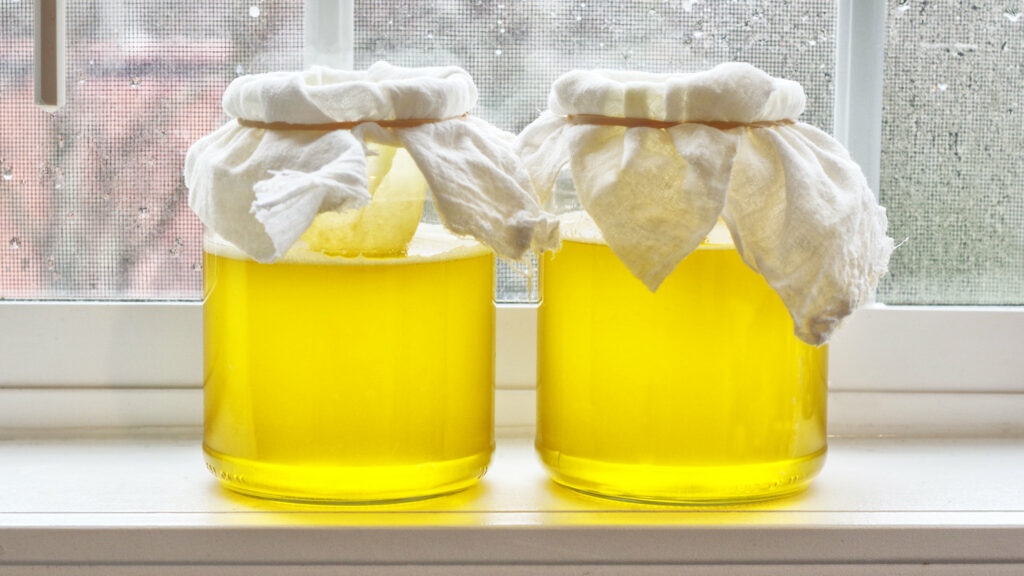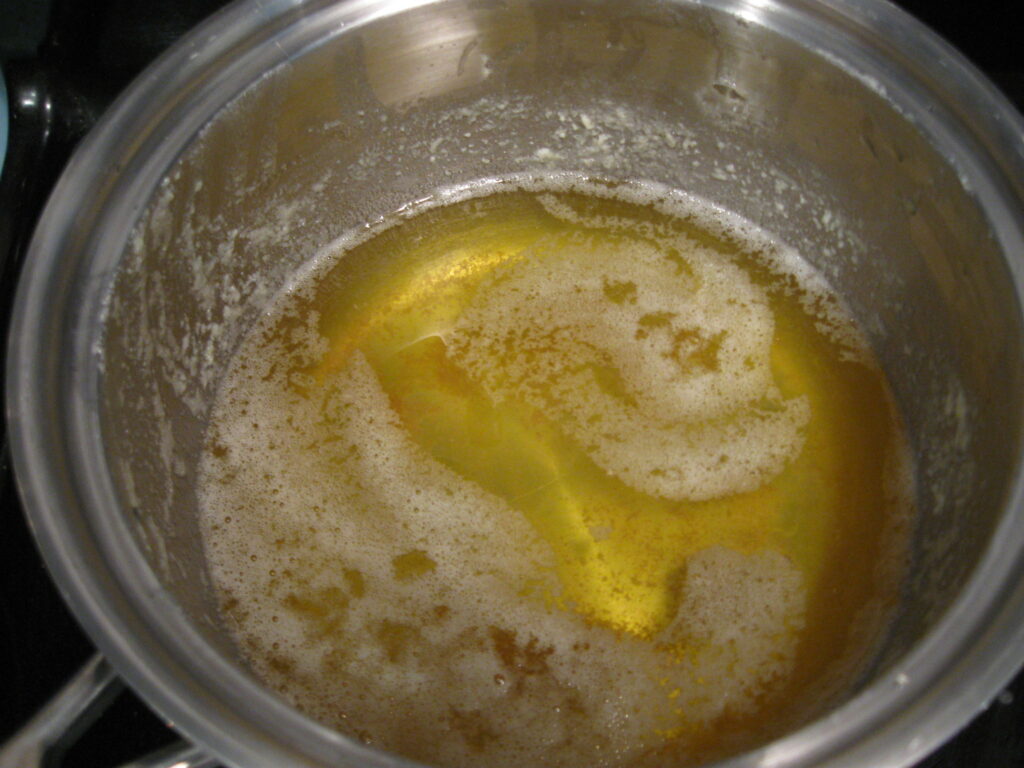

The health benefits of ghee is not any more to prove. Among the four types of oily material, ghee is the best one in Ayurveda, because of its power to assimilate effectively the properties of the ingredients added to it without losing its own properties.
Ghee contains 4 important fats
Ghee is one of what we call the Maha Snehas: the four main fats.
Ayurveda describs four types of fats suitable for human consumption.
Ghee – made of cow, or goat, or buffalo … Cow ghee is considered as the best (Ashtanga Hrudaya Sutrasthana 16th chapter).
Oil – Sesame oil, Mustard oil, Coconut oil, etc.
Animal fat
Bone marrow of animals.
Cow ghee is sweet in taste and hence liked by many people. Like every week, I prepare my ghee for the week, look at this beautiful color!
I can tell you that my intestines appreciate it and since I consume it I have no more problems of digestion and transit…
The benefits of ghee :


Beneficial for our intestines: participates in rebalancing the intestinal mucosa, particularly interesting property for small sensitive bellies with intestinal inflammation.
Because we extract fat soluble active principles to make use of therapeutic values of ghee.
Ghee is able to:
- Enhance the shelf life of the preparation
- To enhance the medicine absorption.
- To make the preparation more palatable.
Regulatory action on our transit:
On those with a slow transit, it acts as a support with a slight action of “soft laxative”, anti-inflammatory action will come to calm an inflammatory state, and strengthen the tissues of the intestinal wall
Personally, ghee has helped me enormously with unavoidable revelation of active properties
The incorporation of ghee in our cooking increases the absorption of the active properties of these ingredients.
Ghee is thus considered an excellent carrier of the active properties of the herbs, spices and plants used.
A global digestive support
According to Ayurvedic teachings, ghee has a regulating action on our digestive fire (also called “Agni”) on the three “doshas”: it helps to calm Pitta (whose digestive fire tends to be in excess), while it soothes Vata (whose digestive fire tends to be the opposite), while being relatively neutral for Kapha.
Ghee also has a supportive effect on our digestive system, which indirectly increases our ability to assimilate micronutrients from our food (what our body will “retain” from the digestive process).
As it no longer contains casein or lactose, milk intolerant people digest it extremely well. Interesting content of fat-soluble vitamins A, D, E and K
Vitamin A is important for our eyes: a regular consumption of ghee will contribute to the good functioning of our retina, will facilitate the adaptation of our eyes to the darkness, and will contribute to prevent ocular imbalances (glaucoma, cataract and other degenerations…).
Vitamins D and K are precious for our nervous system and our bones.
Vitamin E has a very powerful anti-oxidant action, and therefore helps to fight and slow down oxidative processes (physiologically normal, like our aging.
Contributes to support our immune system
its actions will be reinforced within the framework of adapted holistic habits (healthy diet, emotional management, etc…)
Beneficial for our brain clarity
According to Ayurvedic teachings, ghee is extremely interesting for people with “excess Vata” which often manifests itself (emotionally/psychologically) by a cerebral hyperstimulation: sleep disorders, mental dispersion/difficulty to concentrate and to carry out a project.
A daily consumption on the medium and long term, would thus help to stabilize our mental, and to anchor the people concerned.
Promotes the vitality of our body
The best ally for our cooking
All fats (oil, butter, margarine) have a “smoke point”: which designates the limit from which we can cook (heat) with a given fat… before its molecular structure is modified (under the action of heat), and becomes harmful.
Of all the quality oils and fats, ghee is the most stable fat.
Its chemical structure allows a very high smoke point (250°C), making ghee the most interesting fat for cooking our food.
It can also be used in pastries instead of butter (which should never be cooked).
we keeps it for a long time.
Water content of a food makes it fragile to conservation, and can make it turn (initiate the oxidation process).
The absence of water in ghee (due to its manufacturing process) allows a long conservation, without fear of seeing it go rancid.
There is no need to keep it in the refrigerator (its properties would even be diminished!): it keeps wonderfully, for several months, at room temperature, in an airtight jar.
A little more, if we use it on our toast: it will be easier to spread on our slices of bread.
Its good little taste: ghee has a subtle nutty flavor, with a soft and smooth texture.
It goes equally well with salty and sweet foods.
The different uses of ghee
- Karnapoorana: ear drops
- Nasya :Nose drops
- Massage (Shata Dhauta Ghrita for reducing internal bleeding and burning sensation,
- Jatyadi Ghrita: to heal wounds faster
- Hair care
- Enema
How we make ghee?


Cow’s milk collected from a healthy cow treated with love and like a mother. Free of hormones, bad feeding and other awful conditions that we can see in industrial animal factory.
Cow’s milk is boiled to ensure that the milk is free from bacteria and is safe for consumption.
Once the milk has cooled down, a spoonful of curd is added to it and stirred gently. Store this mix in a warm place overnight. Once the curd is set, place it in a cool place before the churning process. The curd thus formed is churned using a wooden churner. During this process, the curd separates into butter and buttermilk. This butter which gets collected at the top of the vessel is collected and heated in a pan over medium flame. The butter has to boil till the entire water content evaporates and there is a visible layer of solids at the bottom of the pan. This ghee is filtered and stored in a dry, air-tight container.
Traditional Method 1
- The milk is boiled first
- Then cooled,
- Set it to curdle
- Then churned to extract butter
- Butter is heated to get ghee.
Traditional Method 2
- The milk is boiled first
- The cream part is separated and collected.
- Then churned to extract butter.
- The day before ghee preparation, the butter is added with a tablespoon of curd for fermentation.
- The next day, the fermented butter is heated to get ghee.
Western method of preparation of clarified butter (ghee)
- Collect the cream from milk.
- Heat it to prepare ghee.
Why to we add curd in ghee’s preparation
In the first method, the curd is prepared first with fermentation, then butter, then ghee.
In the second method, the fermentation to the milk cream is done just a day before.
Ghee prepared with fermentation process is less Kapha increasing. Hence, contributes less to cholesterol. It is also easier and light to digest.
Effect of Ghee on Doshas and body tissues
Ghee is sweet, soft, cold in potency, slightly coating, brings about oleation, effective in flatulence, psychiatric disorders, epilepsy, abdominal colic and fullness and fever. It mitigates Vata and Pitta. Ghee improves digestive fire, memory, intelligence, voice, lustre, skin softness, immunity, strength, lifespan, eye strength. It acts as an aphrodisiac, relieves sins, poverty, toxicity and evil spirits. In conditions involving Vata vitiation, Ghee is to be drunk.
Due to its cold property, ghee mitigates Pitta, due to oiliness it mitigates Vata and due to processing with other medicinal herbs, it mitigates Kapha. Among all the medicines to mitigate aggravated Vata and Pitta, ghee is best. Upon consuming ghee routinely, ghee wins over Pitta due to sweet, cold and mildness, which are against the qualities of Pitta. Drinking ghee relieves the colic pain of Pitta origin. Ghee suits to those, aspiring intelligence and good memory power. Ghee is a great antitoxic substance.
it improves digestive power. In the disorders occurring due to suppression of hunger, ghee should be taken at the beginning and at the end of meals.
Oil is heavier to digest when compared to ghee.
When Pitta alone is involved in a disease process, then ghee should not be administered, especially so in Ama condition.
Bottling and storage
Bottling and storage are very important, care should be taken to increase the shelf life of the Ghee.
Bottles should be cleaned properly, dried and sterilized in order to prevent rancidity.
Usually, glass bottles are used. Nowadays plastic containers are also used for easy handling. Plastic containers should be selected in such a way that it should not react or change the quality of Ghee.
References
The effect of ghee (clarified butter) on serum lipid levels and microsomal lipid peroxidation
Comparison between the Effect of Cow Ghee and Butter on Memory and Lipid Profile of Wistar Rats
Ghee : Its Properties, Importance and Health Benefits
Health benefits of ghee (clarified butter) – A review from ayurvedic perspective
Chemical, physicochemical, microbiological and sensory characterization of cow and buffalo ghee
